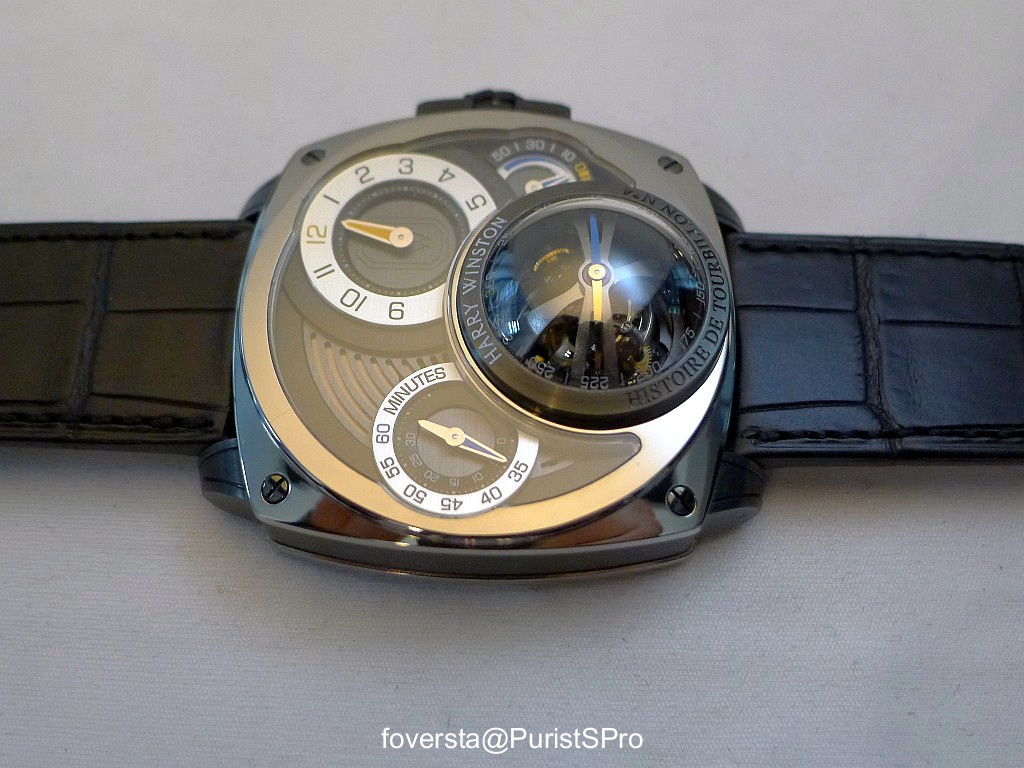
Histoire de Tourbillon 4: the high speed tri-axial Tourbillon.
foversta


Introduction: the pictured watch is a prototype I saw during the SIHH week in January. The final version will get several changes and improvements, the main one being the anti-reflective coating which will be added to the curved-sapphire of the Tourbillon. It is the reason why the prototype was difficult to shoot. Of course, the finishings will be flawless what is not the case of the watch below.
The Histoire de Tourbillon collection has started in 2009 when the first watch was unveiled. HDT1 defined the main features which would be found in each and every piece of the collection:
- a daring design
- a case with a generous size
- an original time display
- and of course, a focus on the hypnotizing behaviour of complex Tourbillons created by CompliTime in partnership with Harry Winston.
The Histoire de Tourbillon collection has started in 2009 when the first watch was unveiled. HDT1 defined the main features which would be found in each and every piece of the collection:
- a daring design
- a case with a generous size
- an original time display
- and of course, a focus on the hypnotizing behaviour of complex Tourbillons created by CompliTime in partnership with Harry Winston.
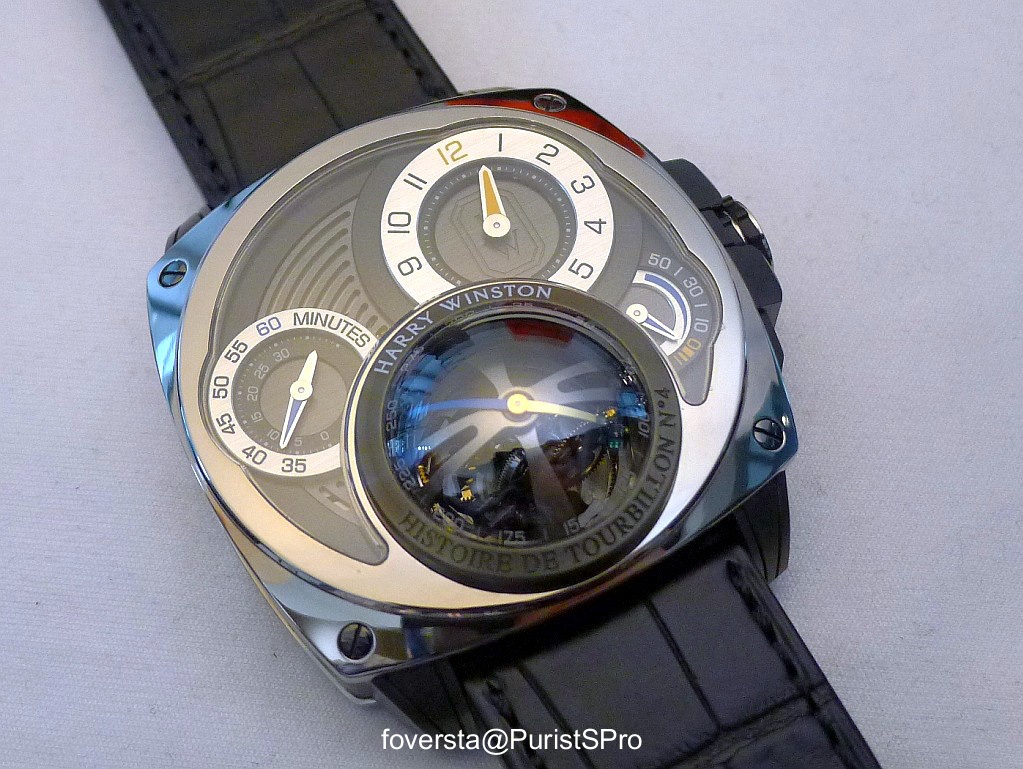
In my point of view, HDT4, whose press release was issued a few days ago, denotes a slight change if we compare it with the 3 previous pieces of the collection. Even if it contains the characteristics listed before, I think it is the most comfortable and easiest watch to wear of the quatuor. Moreover, the daring design of the first 3 of the series had a tendency to be too eye-catching and so to reduce the visual impact of the Tourbillons by themselves. This time, there is no risk: the whole design is dedicated to highlight the main point of interest: the Tourbillon and it is not a mere one!
HDT1 was using two 25° inclined singleaxis Tourbillons with rapid 36?second rotations. Located on the top of the dial, they seemed to float on the air, both being held by an arch-shaped bridge.
HDT2 was featuring a bi-axial flying Tourbillon with two carriages. The inner carriage, inclined at a 10° angle, was doing a full rotation in 40 seconds while the outer carriage in titanium was doing it in 2 minutes.
HDT3 known for its rectangular case could be considered as a logical step forward after the first two watches combining a bi-axial Tourbillon with a mono-axial one. The bi-axial one had the same characteristics of HDT2 combining two carriages with 40 seconds and 2 minutes revolutions. The mono-axial Tourbillon was doing its revolution in 36 seconds like the Tourbillon of HDT1. It is the reason why HDT3 was perceived like a gathering of HDT1 and HDT2 in a single watch!
HDT1 was using two 25° inclined singleaxis Tourbillons with rapid 36?second rotations. Located on the top of the dial, they seemed to float on the air, both being held by an arch-shaped bridge.
HDT2 was featuring a bi-axial flying Tourbillon with two carriages. The inner carriage, inclined at a 10° angle, was doing a full rotation in 40 seconds while the outer carriage in titanium was doing it in 2 minutes.
HDT3 known for its rectangular case could be considered as a logical step forward after the first two watches combining a bi-axial Tourbillon with a mono-axial one. The bi-axial one had the same characteristics of HDT2 combining two carriages with 40 seconds and 2 minutes revolutions. The mono-axial Tourbillon was doing its revolution in 36 seconds like the Tourbillon of HDT1. It is the reason why HDT3 was perceived like a gathering of HDT1 and HDT2 in a single watch!

So what about HDT4?
Obviously, I was expecting that HDT4 would follow the same trend and go even further than HDT3. And Harry Winston managed to meet my expectations with a tri-axial Tourbillon. That's for my technical wish. But I also had an aesthetical one. HDT3 was really a very bold watch with its huge rectangular case. I remember when I put it on my wrist for the first time and I thought that this watch was crazy. I keep thinking the same: it is the reason why HDT3 is a successful watch. Honestly speaking, it was difficult to stay with the same level of extravagance. The surprise wouldn't have been the same and maybe one year later, the clients are expecting something different.
It is the great achievement of HDT4: if we compare it with HDT3, the watch seems to be much classic... even quiet! But if we consider it on its own, HDT4 is a truly original piece with its cushion-shaped case and of course... the bubble on the dial whose objective is to emphasize the Tourbillon behaviour.
Without any hesitation, HDT4 belongs to the Histoire de Tourbillon collection. I feel it instantaneously thanks to the time display and to the chromatic atmosphere.
The time display is very similar to HDT2 with two separated and excentered subdials for the hours and the minutes. On the right top of the dial is located the hours subdial with its classic HDT orange colour. Due to the presence of the large curved sapphire crystal of the Tourbillon, this subdial scale is sadly cut what doesn't improve the legibility of the hours. Hopefully, it is not a main issue because only 3 figures are missing. The engraved Harry Winston logo decorates the center of this subdial, beneath the hand: a discrete way to put it on the dial without losing available space.
Obviously, I was expecting that HDT4 would follow the same trend and go even further than HDT3. And Harry Winston managed to meet my expectations with a tri-axial Tourbillon. That's for my technical wish. But I also had an aesthetical one. HDT3 was really a very bold watch with its huge rectangular case. I remember when I put it on my wrist for the first time and I thought that this watch was crazy. I keep thinking the same: it is the reason why HDT3 is a successful watch. Honestly speaking, it was difficult to stay with the same level of extravagance. The surprise wouldn't have been the same and maybe one year later, the clients are expecting something different.
It is the great achievement of HDT4: if we compare it with HDT3, the watch seems to be much classic... even quiet! But if we consider it on its own, HDT4 is a truly original piece with its cushion-shaped case and of course... the bubble on the dial whose objective is to emphasize the Tourbillon behaviour.
Without any hesitation, HDT4 belongs to the Histoire de Tourbillon collection. I feel it instantaneously thanks to the time display and to the chromatic atmosphere.
The time display is very similar to HDT2 with two separated and excentered subdials for the hours and the minutes. On the right top of the dial is located the hours subdial with its classic HDT orange colour. Due to the presence of the large curved sapphire crystal of the Tourbillon, this subdial scale is sadly cut what doesn't improve the legibility of the hours. Hopefully, it is not a main issue because only 3 figures are missing. The engraved Harry Winston logo decorates the center of this subdial, beneath the hand: a discrete way to put it on the dial without losing available space.
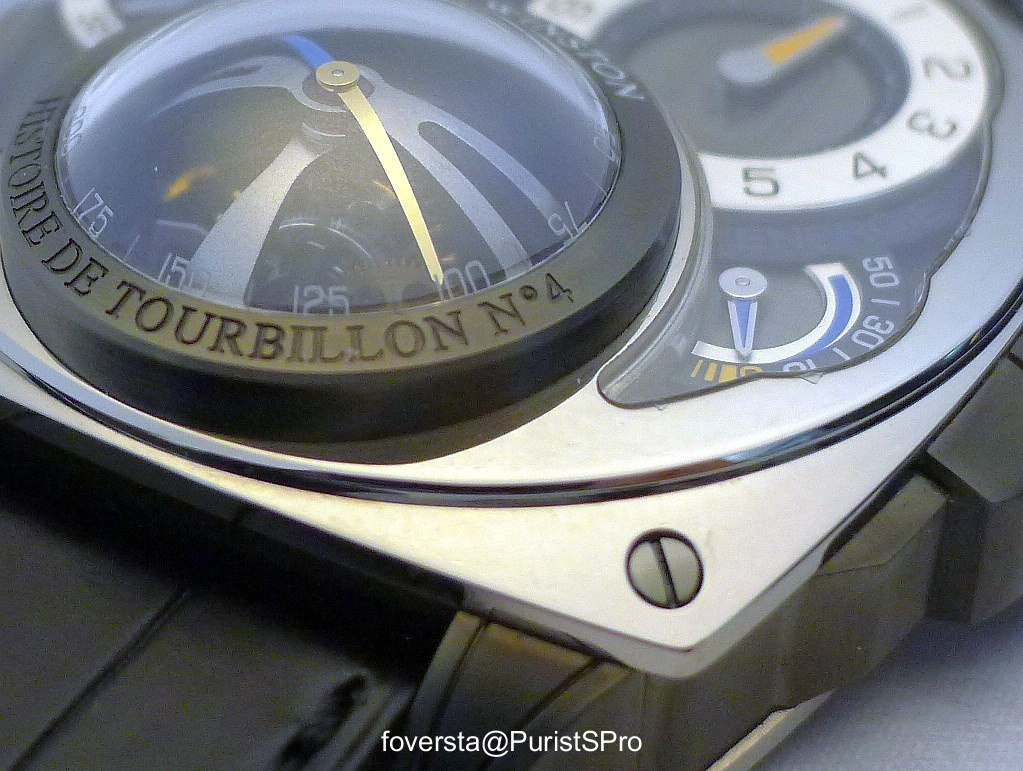
At first glance, it is the same legibility problem with the minutes subdial. It is even more problematic because the half part of the 5mn index is missing. But there is a trick to overcome this absence thanks to a two-blades hand. The smaller side is used to read the first half of the hour while the larger side with a blue end displays the second half. Even if it is not the first time we see this system, it requires a few days (at least for me) to be used with it.
The power reserve indicator is inserted on the right side of the dial and keeps the same blue and orange colours what is a very good point. Like with HDT3, it is graduated up to 50 because both watches share in common the same power display: 50 hours.
As a whole, the dial is very typical to the Harry Winston style with its several layers, its feeling of depth, the off-centered subdials. It is a bit too talkative with a lot of text in each corner. In this context, the presence of these letters is not shocking, they enhance the technical atmosphere of the watch and some may even fade in their backgrounds. The black galvanic flange and appliques, the applied indicators, the different colours of the index combine perfectly to create this consistent design.
As you can feel it by observing the watch, all these displays seem to be secondary: they are oganized around the curved sapphire crystal of the Tourbillon to make it as large as possible. Actually, our eyes are immedialty attracted by this bubble-shaped display which literally pops up!
The power reserve indicator is inserted on the right side of the dial and keeps the same blue and orange colours what is a very good point. Like with HDT3, it is graduated up to 50 because both watches share in common the same power display: 50 hours.
As a whole, the dial is very typical to the Harry Winston style with its several layers, its feeling of depth, the off-centered subdials. It is a bit too talkative with a lot of text in each corner. In this context, the presence of these letters is not shocking, they enhance the technical atmosphere of the watch and some may even fade in their backgrounds. The black galvanic flange and appliques, the applied indicators, the different colours of the index combine perfectly to create this consistent design.
As you can feel it by observing the watch, all these displays seem to be secondary: they are oganized around the curved sapphire crystal of the Tourbillon to make it as large as possible. Actually, our eyes are immedialty attracted by this bubble-shaped display which literally pops up!
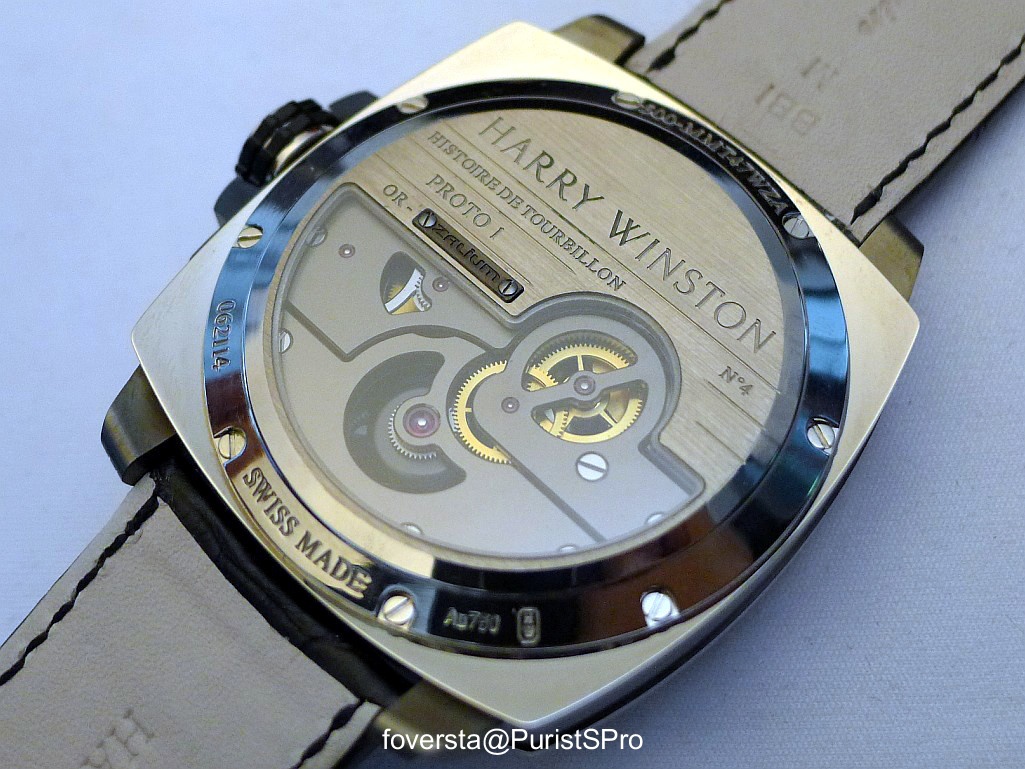
We may think about the Christophe Colomb by Zenith which presented several years ago a watch with a similar bubble on the case (and even on the caseback). But technically speaking, the mechanisms inside the bubbles are totally different. The Zenith watch contains a regulating organ which works like a roly-poly toy in order to get a horizontal position and so to try to escape from the influence of gravity. It is not a Tourbillon. On the other hand, HDT4 bubble houses a tri-axial Tourbillon which has the same objective (to reduce the influence of gravity and to improve the accuracy) but not by using the gravity to escape from it. The tri-axial Tourbillon has its own behaviour and doesn't depend on the wrist movements.
The regulating organ is located inside three concentric cages, each of them having its own angle, its own speed to create this intricate and fascinating behaviour. The inner cage does a full rotation every 45 seconds, the intermediate cage every 75 seconds and the outer cage every 5 minutes. All together, they create this ballet which seem to work randomly... for our deepest pleasure! 3 Tourbillon cages working at the same time require a lot of energy. In order to reduce this consumption impact, the Tourbillon weight was set at 1,57g.
The regulating organ is located inside three concentric cages, each of them having its own angle, its own speed to create this intricate and fascinating behaviour. The inner cage does a full rotation every 45 seconds, the intermediate cage every 75 seconds and the outer cage every 5 minutes. All together, they create this ballet which seem to work randomly... for our deepest pleasure! 3 Tourbillon cages working at the same time require a lot of energy. In order to reduce this consumption impact, the Tourbillon weight was set at 1,57g.
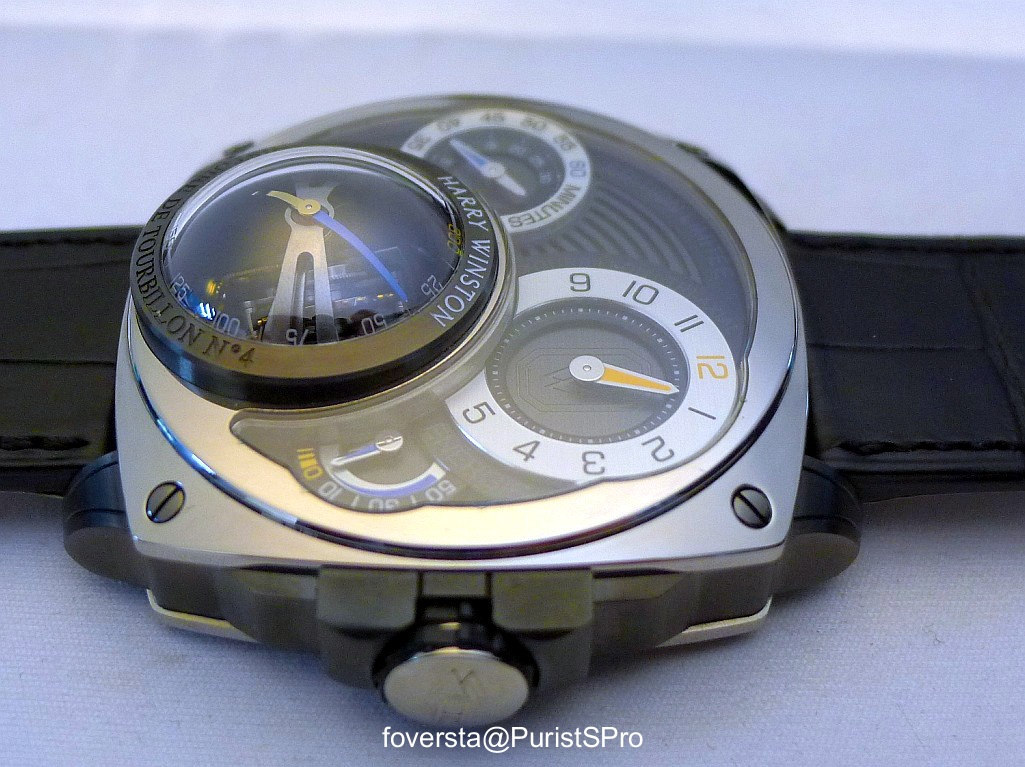
Taking into account the rotation speed of the outer cage, the curved sapphire is graduated with a 300 seconds scale due to the presence of a second hand. We are reaching here the point which is for me a small disappointment. I would have not put a second hand. The Tourbillon is already supported by a fixed carriage pillar and a moving one. The second hand on top of it hides a bit the view of the Tourbillon and due to the fact that the hand does a full revolution in 5 minutes, it doesn't bring anything functinal feature and spoils a bit the pleasure. Anyway, thanks to the bubble, there is a lot to observe from the top but also when you look at the Tourbillon through the sapphire sides.
It is not the first time we see a tri-axial Tourbillon in a wristwatch. Thomas Prescher presented his Triple Axis Tourbillon several years ago. But the speed of the last "dimension" was slower because the third axis was doing a full revolution in one hour. Prescher's Tourbillon was a flying one in order to make it as enjoyable as possible. Harry Winston took another option: the speed is increased (by 12 times for the outer carriage) and the Tourbillon is "more protected" by the carriage pillars. What we lose in terms of availability for the view, we earn it in terms of speed.
It is not the first time we see a tri-axial Tourbillon in a wristwatch. Thomas Prescher presented his Triple Axis Tourbillon several years ago. But the speed of the last "dimension" was slower because the third axis was doing a full revolution in one hour. Prescher's Tourbillon was a flying one in order to make it as enjoyable as possible. Harry Winston took another option: the speed is increased (by 12 times for the outer carriage) and the Tourbillon is "more protected" by the carriage pillars. What we lose in terms of availability for the view, we earn it in terms of speed.
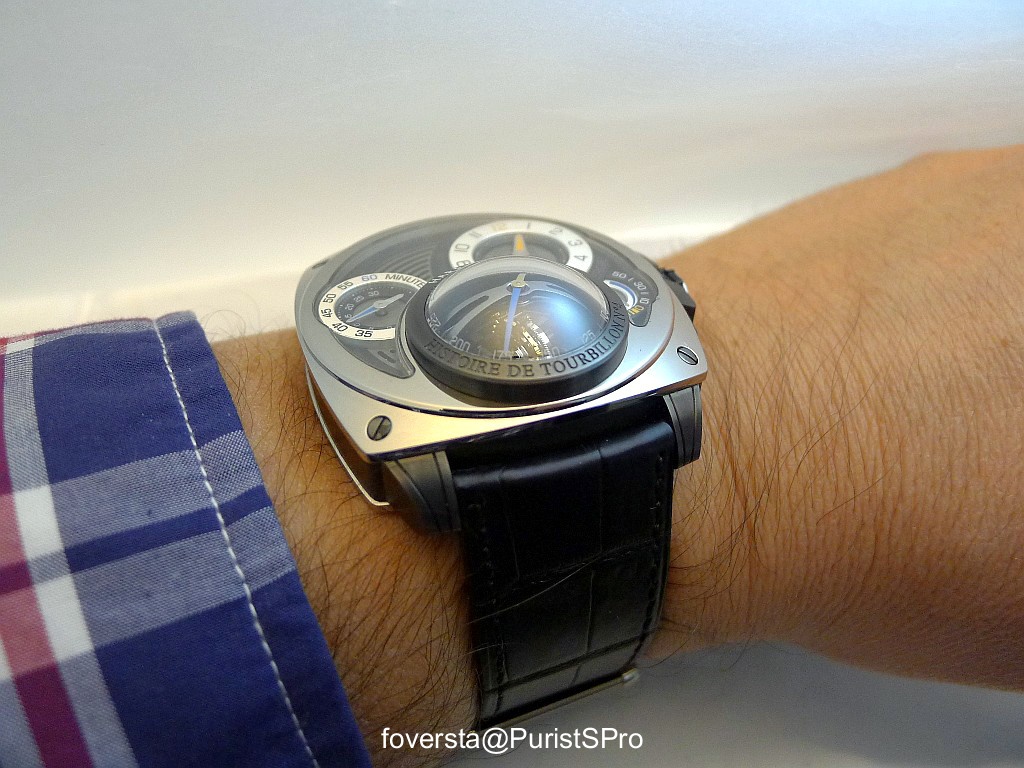
Due to the presence of such impressive organ dial side, the back looks much quieter but we can appreciate the very clean curves of the titanium main plate and its micro-blasted treatment. Harry Winston used titanium for the bridges and the mainplate to optimize the weight of the movement and of the watch. The handwind movement created by CompliTime is equipped with twin barrels in series. Its frequency is 3 hz and it has a power reserve of 50 hours.
Time is coming to speak about the white gold case. With a diameter of 47mm, it seems to be huge. We are inside the HDT collection after all! But as I said before, HDT4 is a watch with a different approach. I decided to forget the case dimensions and to just feel the comfort on the wrist. It is a significant improvement when compared with the previous watches. Thanks to the short lugs, the cushion shape, the use of Zalium for the case bands, the efficiency of the strap, the lightness of the watch, it was well positionned on my wrist and despite its generous size, I never felt to be in the same context than with HDT3. HDT4 is a very wearable and light watch even if the max height is 21,7mm: the bubble has its own charm, its importance and also its own issue!
Time is coming to speak about the white gold case. With a diameter of 47mm, it seems to be huge. We are inside the HDT collection after all! But as I said before, HDT4 is a watch with a different approach. I decided to forget the case dimensions and to just feel the comfort on the wrist. It is a significant improvement when compared with the previous watches. Thanks to the short lugs, the cushion shape, the use of Zalium for the case bands, the efficiency of the strap, the lightness of the watch, it was well positionned on my wrist and despite its generous size, I never felt to be in the same context than with HDT3. HDT4 is a very wearable and light watch even if the max height is 21,7mm: the bubble has its own charm, its importance and also its own issue!
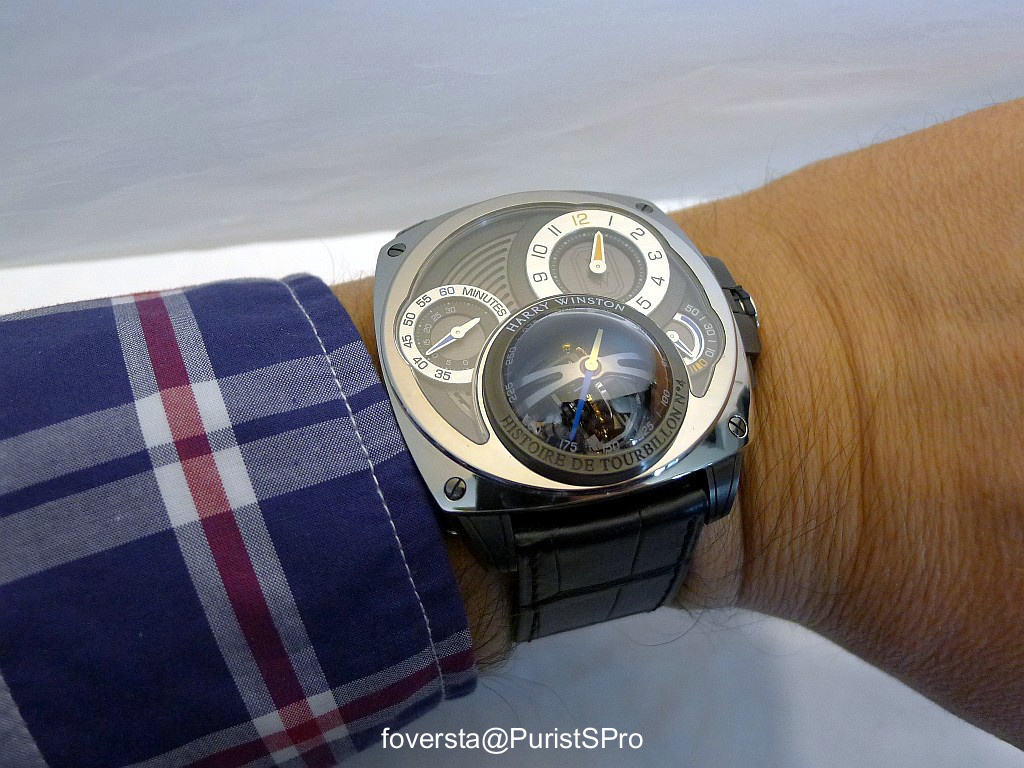
Once put on the wrist, you only see the bubble and what is inside. Time display is almost forgotten! Despite the second hand and the carriage pillars, the speed of the Tourbillon and its behavious make it hypnotizing. We find again the classic feeling of any HDT watch: the contrast between the delicacy of the Tourbillon and the powerful design emphasized by the case size. Very quickly, I move my wrist in order to make the bubble height visible and to enjoy the Tourbillon with another perspective: the curved-sapphire finds its full interest here!
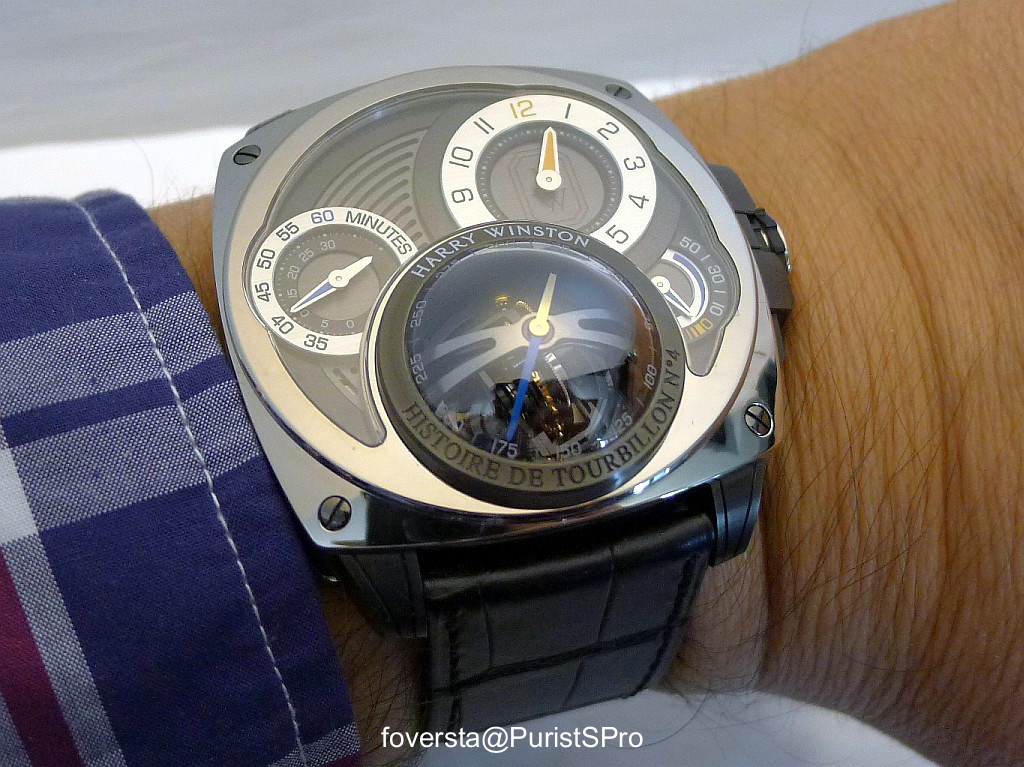
I consider HDT4 as the most convincing and attractive watch of the HDT collection. The comfort on the wrist and the speed of its tri-axial Tourbillon are its biggest assets. It successfully manages to combine the originality of the HDT collection with a more reasonable approach. Bold and daring without being excessive, HDT4 seduced me by its more mature style. I can't wait now to discover the final version during the Basel Fair!
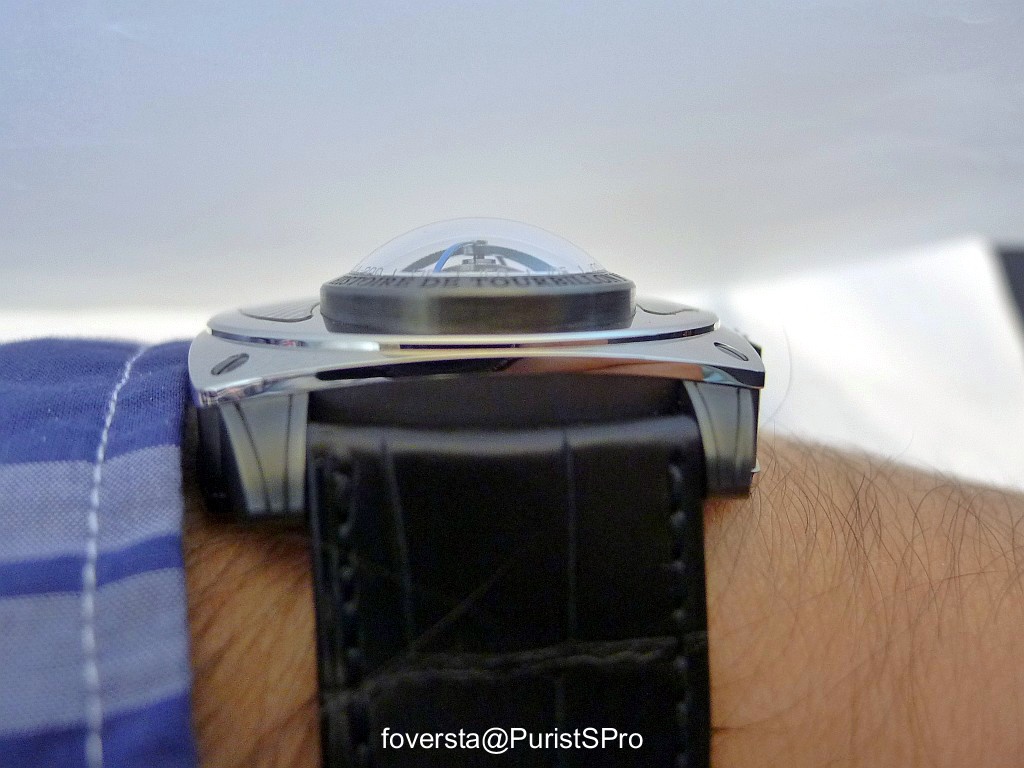
+:
- the comfort on the wrist despite the big case size
- the lightness of the watch
- the speed of the Tourbillon, especially of the outer cage
- the curved sapphire which improves the visibility of the Tourbillon
-:
- the presence of the second hand which was not mandatory
- the legibility of the minutes subdial requires time to get used with it
- the max height of the curved sapphire
Thanks a lot to the Harry Winston team at the Manufacture for the warm welcome!
Fr.Xavier
Comments:

MTF February 24th, 2013-08:14
Will they reach 6 degrees of freedom for HdT-7? FrX, Thanks for the report. The Harry Wioston HdT-4 looks almost 'wearable' by normal people. The Thomas Prescher watch was technically a triple-axis tourbillon but as you said, not perceived because the 3rd cage took 1 hour to revolve. We are so into spe...

foversta February 25th, 2013-12:57
Who knows Melvin? But it becomes more and more complicated to go each time forward. If I'm not wrong, you will not have a HDT7 because I think that they will stop at 6. But to be confirmed. Fx
0-10-2
Load More Comments
Next Article
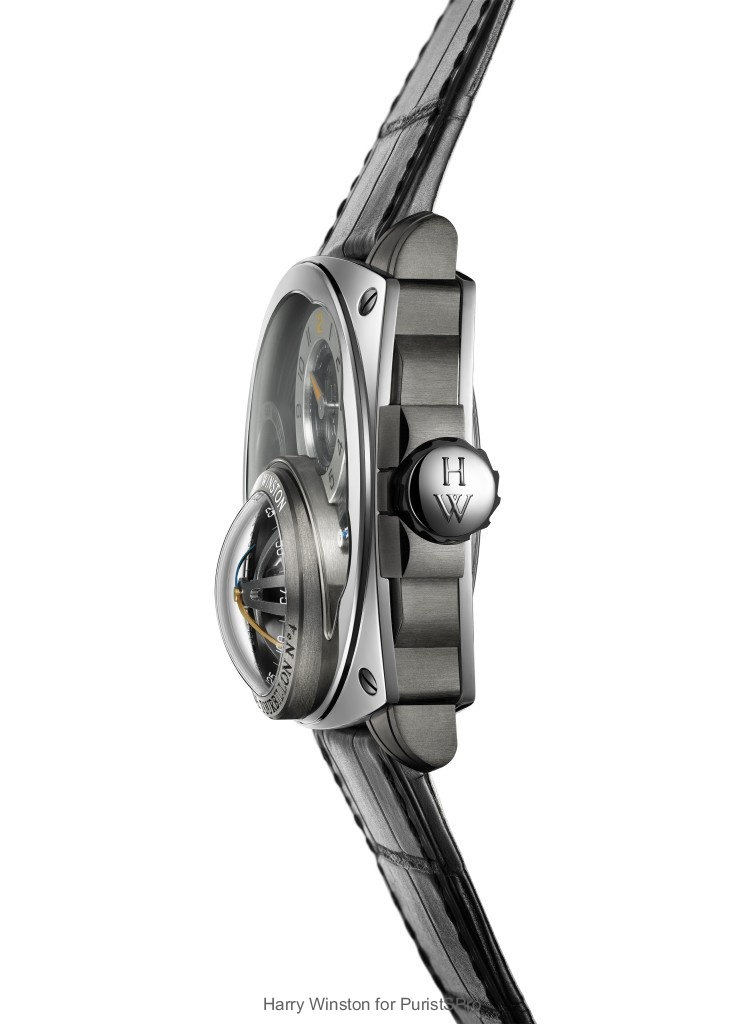
foversta


Press Release: Harry Winston Histoire de Tourbillon 4
foversta


PRESS RELEASE HARRY WINSTON HISTOIRE DE TOURBILLON 4 For all of the complexity that the tourbillon embodies, it began with a beautiful idea; and like most beautiful things, the idea itself was very simple. A watch, after all, is a machine of wonderful economy. There is an oscillator, or a circular balance, which swings back and forth a specific number of times per second. Essentially, the whole rest of the watch exists to count the number of beats per second of the oscillator at its heart, and as long as ...
© 2017 - WatchProZine